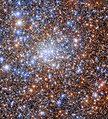Datei:Terzan4 - HST - Potw2237a.jpg

Originaldatei (2.611 × 2.888 Pixel, Dateigröße: 4,2 MB, MIME-Typ: image/jpeg)
![]()
Diese Datei und die Informationen unter dem roten Trennstrich werden aus dem zentralen Medienarchiv Wikimedia Commons eingebunden.
Beschreibung
| BeschreibungTerzan4 - HST - Potw2237a.jpg |
English: Starstruck in Terzan 4
The launch of Hubble in 1990 revolutionised the study of globular clusters. The individual stars in these dense crowds are almost impossible to distinguish from one another with ground-based telescopes, but can be picked apart using space telescopes. Astronomers have taken advantage of Hubble’s crystal-clear vision to study the stars making up globular clusters, as well as how these systems change over time. This particular observation comes from astronomers using Hubble to explore Terzan 4 and other globular clusters to understand the shape, density, age, and structure of globular clusters close to the centre of the Milky Way. Unlike globular clusters elsewhere in the sky, these globular clusters have evaded detailed observation because of the clouds of gas and dust swirling around the galactic core. These clouds blot out starlight in a process that astronomers refer to as ‘extinction’, and complicate astronomical observations. Astronomers took advantage of the sensitivity of two of Hubble’s instruments — the Advanced Camera for Surveys and Wide Field Camera 3 — to overcome the impact of extinction on Terzan 4. By combining Hubble imagery with sophisticated data processing, astronomers were able to determine the ages of galactic globular clusters to within a billion years — a relatively accurate measurement in astronomical terms! Credit: ESA/Hubble & NASA, R. Cohen
Coordinates Position (RA): 17 30 38.19 Position (Dec): -31° 35' 43.44" Field of view: 2.18 x 2.41 arcminutes Orientation: North is 58.2° right of vertical Colours & filters Band Wavelength Telescope Optical V 606 nm Hubble Space Telescope ACS Infrared YJ 1.1 μm Hubble Space Telescope WFC3 Infrared H 1.6 μm Hubble Space Telescope WFC3. |
|||
| Datum | 12 September 2022, 06:00(released) | |||
| Quelle | https://esahubble.org/images/potw2237a/ | |||
| Urheber |
Credit: ESA/Hubble & NASA, R. Cohen |
|||
| Genehmigung (Weiternutzung dieser Datei) |
Diese Datei ist lizenziert unter der Creative-Commons-Lizenz „Namensnennung 4.0 international“. Namensnennung: Credit:
|
Kurzbeschreibungen
4.407.463 Byte
2.888 Pixel
2.611 Pixel
image/jpeg
e5716014ae1c18e579f5e18204249ae3657ebdc3
Dateiversionen
Klicke auf einen Zeitpunkt, um diese Version zu laden.
| Version vom | Vorschaubild | Maße | Benutzer | Kommentar | |
|---|---|---|---|---|---|
| aktuell | 20:32, 12. Sep. 2022 |  | 2.611 × 2.888 (4,2 MB) | wikimediacommons>Fabian RRRR | == {{int:filedesc}} == {{Information |description={{en|1='''Starstruck in Terzan 4 A glittering multitude of stars in the globular cluster Terzan 4 fill this image from the NASA/ESA Hubble Space Telescope. Globular clusters are collections of stars bound together by their mutual gravitational attraction, and can contain millions of individual stars. As this image shows, the heart of a globular cluster such as Terzan 4 is a densely packed, crowded field of stars — which makes for spectacular... |
Dateiverwendung
Die folgenden 2 Seiten verwenden diese Datei:
Metadaten
Diese Datei enthält weitere Informationen (beispielsweise Exif-Metadaten), die in der Regel von der Digitalkamera oder dem verwendeten Scanner stammen. Durch nachträgliche Bearbeitung der Originaldatei können einige Details verändert worden sein.
| Bildtitel |
|
|---|---|
| Erfassungszeitpunkt | 06:00, 12. Sep. 2022 |
| Software | Adobe Photoshop 23.4 (Windows) |
| Speicherzeitpunkt | 16:30, 8. Sep. 2022 |
| Digitalisierungszeitpunkt | 13:19, 30. Jun. 2022 |
| Datum zu dem die Metadaten letztmalig geändert wurden | 18:30, 8. Sep. 2022 |
| Quelle | ESA/Hubble |
| Namensnennung/Veröffentlicher | ESA/Hubble & NASA, R. Cohen |
| Eindeutige Kennung des ursprünglichen Dokuments | xmp.did:8be115bc-5372-4e43-8d8b-a93ed57d75fe |
| Kurztitel |
|
| Kontaktinformationen |
ESA Office, Space Telescope Science Institute, 3700 San Martin Dr Baltimore, MD, 21218 United States |
| Nutzungsbedingungen |
|
| IIM-Version | 4 |

